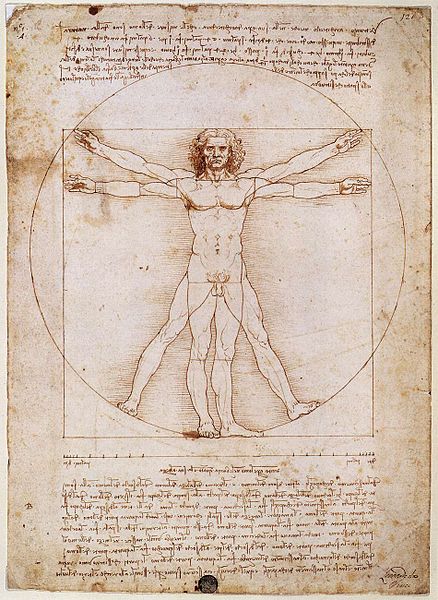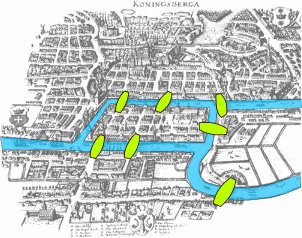This is a guest post written by David Nkansah, a mathematics student at the University of Glasgow.
Around the fourth century BC, the term ‘Mathematics’ was defined by Aristotle as the “science of quantity”. It’s my own experience as a young mathematician to say this definition, although correct in its own right, poses a problem for those who do not truly know what mathematics is. It fails to highlight the true creativity of the subject.
Human inspiration and imagination are essential ingredients in mathematics. Regarding creativity, one could say, with merit, that in a sense mathematics is an art. Before proceeding to outline similarities between sketching mathematical proofs and painting on a canvas, it is important to know what fundamental premises mathematical proofs are built on.

Da Vinci’s Vitruvian Man (1490)
Axioms are the fundamental building blocks of all mathematical proofs. Generally, the game of mathematics is to prove logical statements beyond all conceivable doubt, and this process can be laborious and tedious. When a proof has been discovered, it is structured by logical statements that follow from one another: Suppose we are trying to prove a statement C, and assume statement A is true, we have that A implies B, and then we find that B implies C. Therefore, if A is true, then the statement C is also true, and that there ends our proof. Arguments like this are thoroughly scrutinised by mathematicians, checking if all logical implications are justified and true. When a step is unclear, one must tweak the proof so that the step in question becomes clear.
We may be asked why a specific statement is actually true, say, why B actually implies C? We would have to give justification as to why; however, what if our justification is again questioned, repeatedly? This procedure could then repeat, break statements into smaller sub statements until finally, we hit the axioms. The axioms are universally accepted as true, and so we can then build up implications from these true statements.
A natural question that arises here may be, why should we accept the axioms to be fundamentally true? A mathematician might respond: Firstly, the axioms are so intuitive that they would seem logically true to anyone who came across them, and secondly, it is not the truthfulness of the axioms that concerns mathematicians, but more the usefulness and their consistency.

The Seven Bridges of Königsberg
Now that we have established what fundamental premises mathematical proofs are built on, we can now outline the similarities between sketching a proof in mathematics and painting a canvas in art. A trivial beginning to both processes is learning the basics. Undeniably inspiration is the starting point to both sketching a proof and creating an artwork on a canvas. Inspiration can be found in everyday life, as Euler did with the Königsberg bridges problem in 1736, or as Da Vinci did with his Vitruvian Man (c. 1490, above). Inspiration could also occur unexpectedly – this could happen when mathematicians play around with specific results and notice a pattern emerge. They then might wonder whether this pattern holds true always.
Once inspiration strikes in order to execute the work, a basic foundation of knowledge, in both disciplines, is necessary. In mathematics, this means learning the definitions and rules that are needed in your work, whereas in art one must learn the technical rules of perspective and how to mix and apply paint. The next step is to sketch the outline of the work which will later be filled in with logical implications and artistic visual elements. In maths, outlining your work means to write down all that is given and known, while an artist must outline their compositions, ensuring placement and perspective are well planned. For both, experience is then essential to create a successful final product.
Artists produce paintings that allow the viewer to visualise things they may have never seen, or visualise things in a different light; this skill, however, is not unique to just the artist.
Through mathematics, we can come to visualise concepts that could never be represented in a painting. A discipline in mathematics that most people are familiar with is geometry, a very pictorial subject. However, when geometry meets higher dimensions we lose this tangible imagery. Despite this, mathematics can provide an answer in a way that art cannot: it abstracts. As Timothy Gowers so artfully explains:
“Although I do not have a completely clear picture of four-dimensional space, I can still ‘see’ that there are twelve edges for each of the two-dimensional cubes, and 8 edges linking their vertices together. This gives a total of 12 + 12 + 8 = 32. Then I can ‘just see’ that a five-dimensional cube is made up of two of these, again with corresponding vertices linked, making a total of 32 + 32 + 16 = 80 edges (32 for each four-dimensional cube and 16 for the edges between them), exactly the answer I obtained before. Thus, I have some rudimentary ability to visualise in four and five-dimensions before.”
Tim Gowers, Mathematics: A Very Short Introduction
Gowers shows his ability to capture the shadow of higher dimensional shapes with elementary mathematics, again, one could argue this visualisation has no merit because we cannot actually see in four or five dimensions – however, just like an artist, Gowers paints a consistent and ‘rudimentary’ image.
When looking at axiomatic systems, people tend to be rigid and to lack creativity, however, we have seen that it can be full of creativity, which is a part of mathematics that eludes many but is so very important to ensure the advancement of the field. And so, I urge you, the reader, never to forget that practising mathematics is practising an art, as well as a science of quantity.
Further Reading
An Aristotelian Realist Philosophy of Mathematics, by James Franklin.
Mathematics: A Very Short Introduction, by Timothy Gowers.